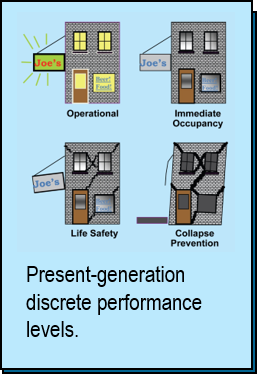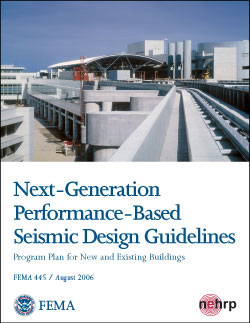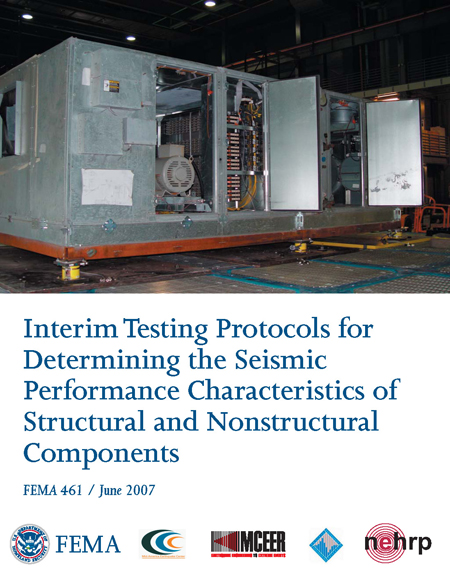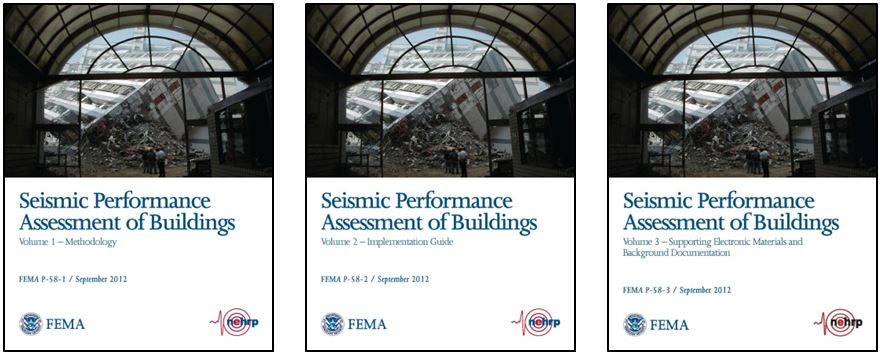History of FEMA P-58
PROJECT OVERVIEW
In 2001, the Applied Technology Council (ATC) was awarded the first in a series of contracts with the Federal Emergency Management Agency (FEMA) to develop Next-Generation Performance-Based Seismic Design Procedures for New and Existing Buildings. These projects would become known as the ATC-58 Series of Projects. The overall program was separated into two major phases of work: Phase 1 – Developing a Methodology for Assessing the Seismic Performance of Buildings; and Phase 2 – Developing Performance-Based Seismic Design Procedures and Guidelines. The principal product of this work is a series of volumes, background documentation, and electronic materials collectively referred to as the FEMA P-58 Seismic Performance Assessment of Buildings, Methodology and Implementation.
PROJECT CONTEXT
 Performance-based seismic design in its current form originated in the 1990s. Present-generation performance-based procedures are based on FEMA 273, NEHRP Guidelines for the Seismic Rehabilitation of Buildings (FEMA, 1997), which addressed seismic retrofit of existing buildings, and outlined initial concepts of performance levels related to damageability and varying levels of seismic hazard. In present-generation procedures, performance is expressed in terms of a series of discrete performance levels identified as Operational, Immediate Occupancy, Life Safety, and Collapse Prevention. Although these discrete levels established a vocabulary and provided a means by which engineers could quantify and communicate seismic performance to clients and other stakeholders, use of present-generation procedures in practice uncovered certain limitations, and identified needed enhancements.
Performance-based seismic design in its current form originated in the 1990s. Present-generation performance-based procedures are based on FEMA 273, NEHRP Guidelines for the Seismic Rehabilitation of Buildings (FEMA, 1997), which addressed seismic retrofit of existing buildings, and outlined initial concepts of performance levels related to damageability and varying levels of seismic hazard. In present-generation procedures, performance is expressed in terms of a series of discrete performance levels identified as Operational, Immediate Occupancy, Life Safety, and Collapse Prevention. Although these discrete levels established a vocabulary and provided a means by which engineers could quantify and communicate seismic performance to clients and other stakeholders, use of present-generation procedures in practice uncovered certain limitations, and identified needed enhancements.
The objectives of the ATC-58 Series of Projects were to:
- Develop a framework for performance assessment that properly accounts for, and adequately communicates to stakeholders, limitations in our ability to accurately predict response, and uncertainty in the level of earthquake hazard.
- Revise the discrete performance levels defined in present-generation procedures to create new performance measures that better relate to the decision-making needs of stakeholders.
- Create procedures for estimating these new performance measures for both new and existing buildings.
- Expand current nonstructural procedures to explicitly assess the damageability and post-earthquake condition of nonstructural components and systems.
- Modify current structural procedures to assess performance based on global response parameters, so that the response of individual components does not unnecessarily control the prediction of overall structural performance.
ATC-58 PROJECT
 The ATC-58 Project focused on reviewing and updating the program plan presented in the FEMA-349 Action Plan for Performance Based Seismic Design, which defined the work necessary to develop the following series of products: Structural Performance Products, Nonstructural Performance Products, Risk Management Products, Design Guidelines, and Stakeholders Guidelines. The principal outcomes of the ATC-58 Project included:
The ATC-58 Project focused on reviewing and updating the program plan presented in the FEMA-349 Action Plan for Performance Based Seismic Design, which defined the work necessary to develop the following series of products: Structural Performance Products, Nonstructural Performance Products, Risk Management Products, Design Guidelines, and Stakeholders Guidelines. The principal outcomes of the ATC-58 Project included:
- A revised program plan, which was published and released in August 2006 as FEMA 445, Next-Generation Performance-Based Seismic Design Guidelines, Program Plan for New and Existing Buildings .
- The development of FEMA 461,
Interim Testing Protocols for Determining the Seismic Performance Characteristics of Structural and Nonstructural Components
, published and released in June 2007.

- The preparation of a 35% complete draft of the Performance Assessment Methodology and electronic Performance Assessment Calculation Tool (PACT).
ATC-58-1 PROJECT
The ATC-58-1 Project focused on the completion of the Performance Assessment Methodology. Released in 2012, the FEMA P-58, Seismic Performance Assessment of Buildings, Methodology and Implementation initially consisted of three volumes, as follows:
- Volume 1 - Methodology outlines the general methodology and procedures for conducting seismic performance assessments.
- Volume 2 - Implementation Guide provides guidance on conducting seismic performance assessments using the methodology and provides specific instructions on how to assemble and prepare input data necessary for PACT.
- Volume 3 - Supporting Electronic Materials and Background Documentation consists of a series of electronic products assembled to assist engineers in conducting seismic performance assessments and in understanding the technical basis of the methodology.
Together, these volumes described the resulting methodology and provided guidance on the development of basic building information, response quantities, fragilities, and consequence data used as inputs to the methodology. To allow practical implementation of the methodology, work included the collection of available fragility and consequence data for most common structural systems and building occupancies, and the completion of an electronic Performance Assessment Calculation Tool (PACT) for performing the probabilistic computations and accumulating losses.

ATC-58-2 PROJECT
 Upon the completion of the Performance Assessment Methodology under ATC-58-1, the ATC-58-2 Project was initiated to utilize the FEMA P-58 methodology in developing recommendations for specifying seismic performance objectives in terms of FEMA P-58 performance metrics, and to develop guidelines for effectively designing buildings to achieve the desired performance using FEMA P-58 procedures.
Upon the completion of the Performance Assessment Methodology under ATC-58-1, the ATC-58-2 Project was initiated to utilize the FEMA P-58 methodology in developing recommendations for specifying seismic performance objectives in terms of FEMA P-58 performance metrics, and to develop guidelines for effectively designing buildings to achieve the desired performance using FEMA P-58 procedures.
As part of this work, the FEMA P-58 methodology was exercised in assessing the performance of code-conforming buildings, and technical improvements and updates to the methodology were developed, as necessary, to take advantage of the latest research and bring results into better alignment with performance of buildings observed in past earthquakes. ATC-58-2 also included the development of products for communicating seismic performance to stakeholders and assisting decision-makers in choosing between seismic design criteria and making seismic design decisions.
Completed in 2018, the ATC-58-2 Project has updated and expanded the FEMA P-58, Seismic Performance of Buildings, Methodology and Implementation series of volumes to include the following:
- FEMA P-58-1, Seismic Performance Assessment of Buildings, Volume 1 – Methodology, Second Edition
- FEMA P-58-2, Seismic Performance Assessment of Buildings, Volume 2 – Implementation Guide, Second Edition
- FEMA P-58-3, Seismic Performance Assessment of Buildings, Volume 3 – Supporting Electronic Materials and Background Documentation, Third Edition
- FEMA P-58-4, Seismic Performance Assessment of Buildings, Volume 4 – Methodology for Assessing Environmental Impacts
- FEMA P-58-5, Seismic Performance Assessment of Buildings, Volume 5 – Expected Seismic Performance of Code-Conforming Buildings
- FEMA P-58-6, Guidelines for Performance-Based Seismic Design of Buildings
- FEMA P-58-7, Building the Performance You Need, A Guide to State-of-the-Art Tools for Seismic Design and Assessment

